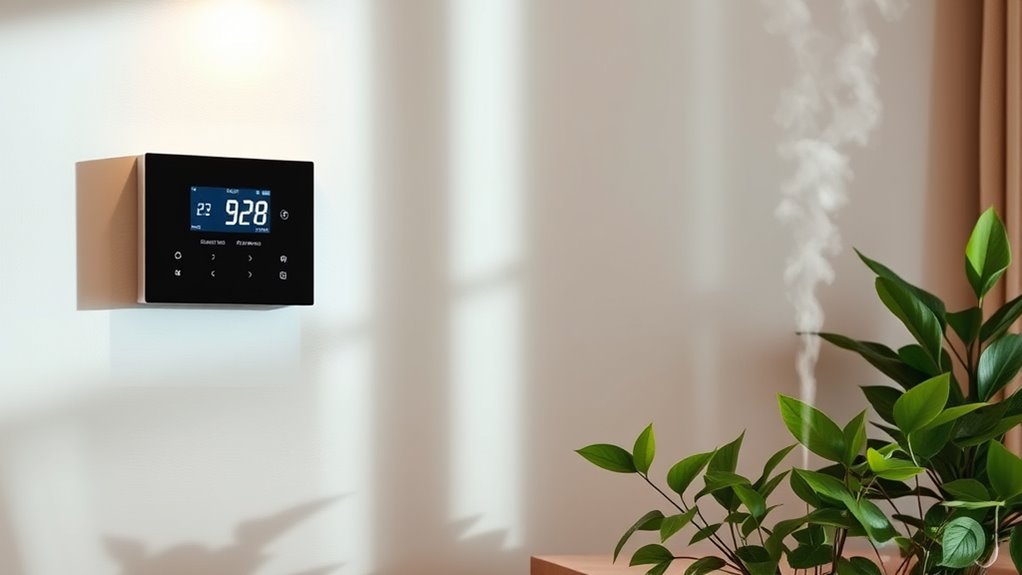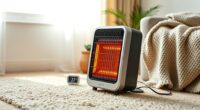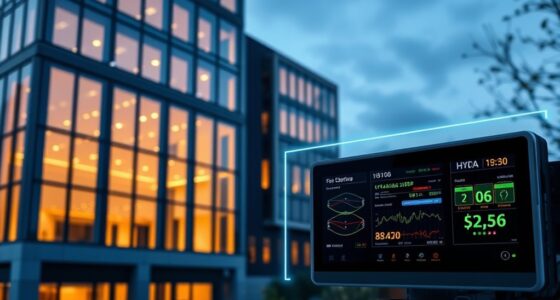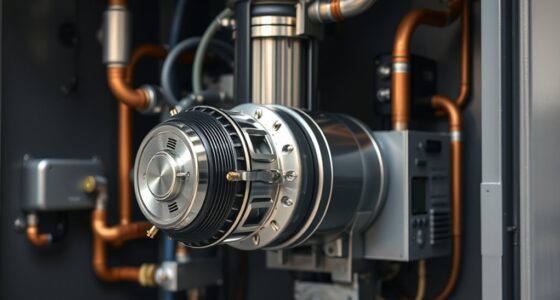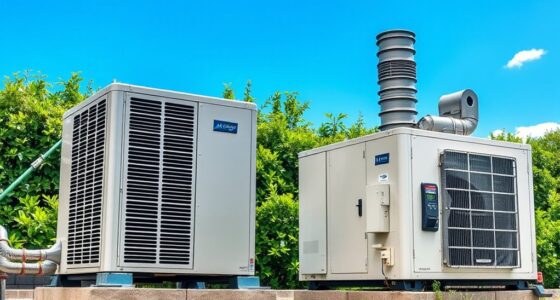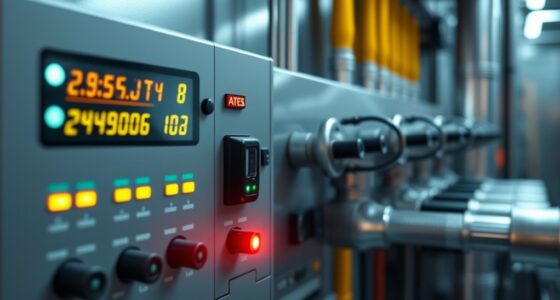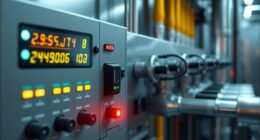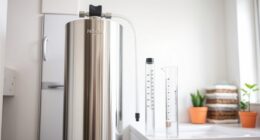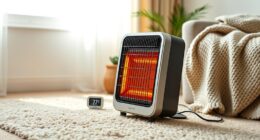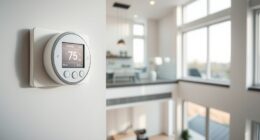To integrate humidity control into your smart home, connect compatible Wi-Fi-enabled dehumidifiers with your preferred smart platform like Alexa or Google Home. Calibrate sensors regularly to guarantee accurate readings, and set specific humidity thresholds to automate device activation. This integration helps maintain ideal comfort, prevents energy waste, and improves indoor air quality. Proper calibration and customization are key, and exploring further will reveal how to enhance your system for maximum efficiency and comfort.
Key Takeaways
- Use compatible Wi-Fi-enabled dehumidifiers that integrate with your smart home platforms like Alexa, Google Home, or Apple HomeKit.
- Calibrate humidity sensors regularly to ensure accurate readings for effective automation.
- Set personalized humidity thresholds (e.g., 40-50%) to optimize comfort and energy efficiency.
- Enable self-calibration features to simplify maintenance and maintain sensor accuracy over time.
- Automate device responses based on sensor data to maintain consistent indoor humidity levels seamlessly.
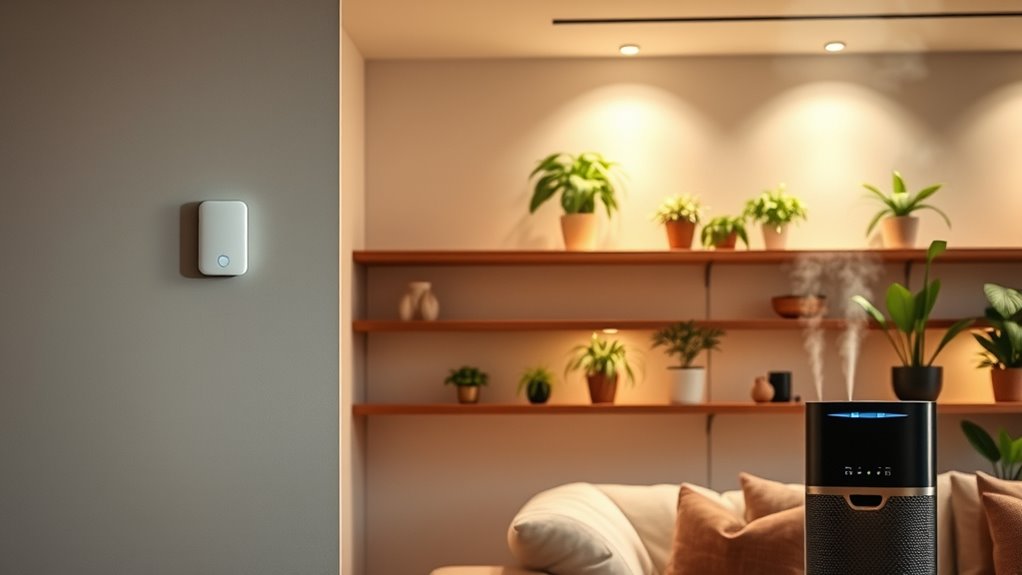
Have you ever noticed how the air in your home can feel damp or dry, affecting your comfort and health? If so, integrating humidity control into your smart home can make a significant difference. Modern systems rely heavily on smart sensor calibration to ensure accurate readings, which is essential for maintaining the perfect indoor environment. When your sensors are properly calibrated, they detect humidity levels precisely, allowing your automation system to respond effectively. Without proper calibration, the sensors might give false readings, causing your dehumidifiers or humidifiers to turn on or off unnecessarily, wasting energy and compromising comfort.
Proper sensor calibration ensures accurate humidity readings for efficient and comfortable smart home climate control.
Automated dehumidifier integration is the key to seamless humidity management. Once your sensors are accurately calibrated, your smart home system can automatically activate or deactivate dehumidifiers based on real-time data. This integration eliminates the need for manual adjustments, giving you consistent comfort and peace of mind. When humidity levels rise above your preferred range, the system kicks in, removing excess moisture efficiently. Conversely, if the air becomes too dry, the system can prompt your humidifier or turn off the dehumidifier, maintaining ideal conditions. The result is a home that adapts dynamically, optimizing your environment without your constant intervention.
To achieve smooth automated dehumidifier integration, you should also guarantee your devices are compatible with your smart home platform. Many modern dehumidifiers come with Wi-Fi connectivity and can be integrated into popular smart home ecosystems like Alexa, Google Home, or Apple HomeKit. Once connected, you can set specific humidity thresholds and customize how your system responds, creating a tailored environment that suits your preferences. For example, you might set the system to maintain humidity between 40-50%, ideal for comfort and health.
You’ll also want to keep an eye on sensor maintenance and calibration over time. Environmental factors, dust, and sensor aging can impact accuracy, so periodic recalibration is necessary. Some smart systems include self-calibration features, simplifying this task. Regular maintenance ensures your humidity control remains precise, preventing issues like mold growth or overly dry air, which can cause breathing discomfort. Additionally, understanding the importance of sensor calibration and its role in accurate humidity detection is crucial for optimal system performance.
Incorporating smart sensor calibration and automated dehumidifier integration into your home transforms the way you manage indoor air quality. It allows your system to respond intelligently to changing conditions, providing a comfortable, healthy environment with minimal effort. When you get these components working together seamlessly, you’ll enjoy the benefits of a truly smart, adaptive home that keeps humidity levels just right—without you having to lift a finger.
Frequently Asked Questions
Can Humidity Sensors Detect Mold Growth Early?
Humidity sensors can help detect mold growth early by monitoring moisture levels accurately. When sensor accuracy is high, you get reliable readings that can alert you to excess humidity, a key factor in mold prevention. By keeping humidity in check with smart sensors, you reduce the risk of mold developing without waiting for visible signs. This proactive approach helps you maintain a healthier home environment and prevent costly mold issues later.
How Often Should I Calibrate My Smart Humidity Devices?
You should calibrate your smart humidity devices every six months to guarantee sensor accuracy. Think of it as a routine device maintenance, similar to tuning up a car. Regular sensor calibration prevents drift and keeps your smart home environment comfortable and healthy. Skipping this step could lead to incorrect readings, making you rely on inaccurate data. Stay proactive with maintenance for reliable humidity control and peace of mind.
Are There Privacy Concerns With Smart Humidity Monitoring?
You might have privacy concerns with smart humidity monitoring, especially regarding data security. These devices collect environmental data, which could potentially be accessed by unauthorized parties if not properly protected. To guarantee your privacy, choose reputable brands with strong encryption, update firmware regularly, and review privacy settings. Being aware of how your data is stored and shared helps you maintain control over your smart home environment and peace of mind.
Can Humidity Control Devices Work During Power Outages?
Yes, humidity control devices can work during power outages if they have a battery backup. This feature guarantees continuous operation, maintaining ideal humidity levels even when the power goes out. To maximize efficiency, choose devices with power-saving modes. Battery backups help you avoid damage caused by excess moisture or dryness, providing peace of mind and protecting your home’s comfort and structure during unexpected outages.
What’s the Ideal Humidity Range for Different Rooms?
You should aim for 30-50% humidity in most rooms to optimize air quality and energy efficiency. Studies show maintaining this range can reduce allergens and mold growth. In bedrooms, keep it closer to 40-50% for comfort, while living areas can be slightly lower. Proper humidity levels help your HVAC work efficiently, saving energy, and create a healthier environment. Monitor regularly to keep your smart home comfortable and safe.
Conclusion
So, now that you’re basically a humidity wizard, you can keep your home perfectly comfy—without breaking a sweat or drowning in moisture. Who knew controlling humidity could be so glamorous? Just think, soon you’ll be the envy of all your friends, bragging about your smart home’s secret weapon. Because nothing screams “high tech” like a climate that’s just right—without you lifting a finger. Welcome to the future of indoor bliss—where humidity is no longer a mystery.
